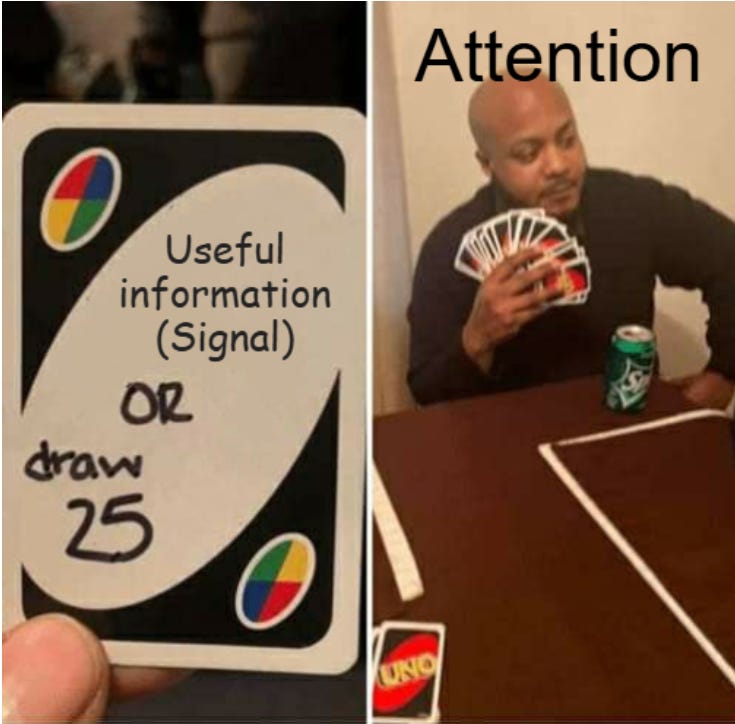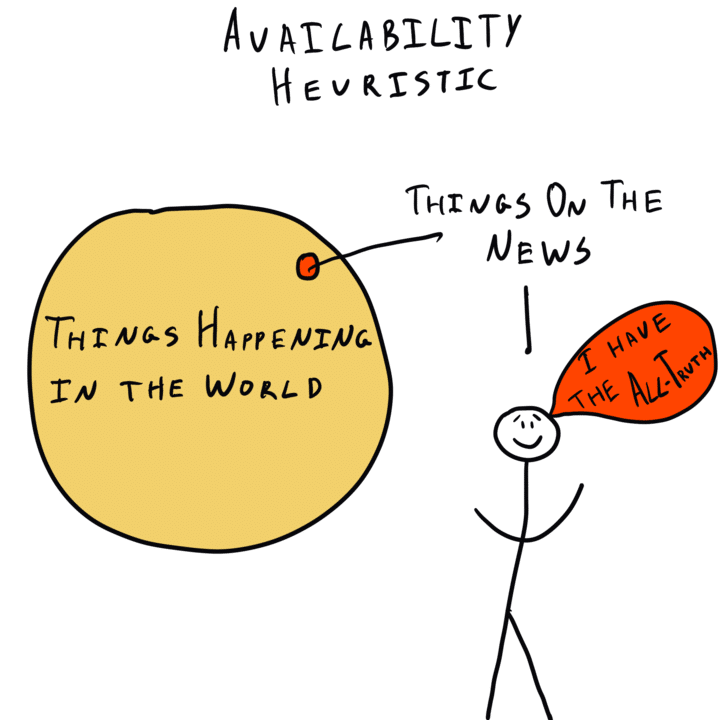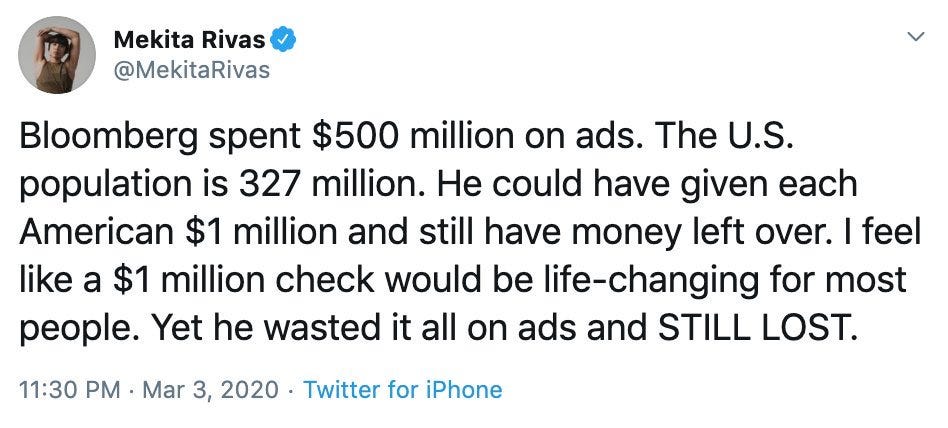"If everyone is thinking alike, then no one is thinking." — Benjamin Franklin
The average human process around 74 gigabytes (GB) of information each day. This is the equivalent of 16 movies, or a slow Marvel year. Some of this information comes from our sensory input, what we see, hear and touch, other pieces happen in our subconscious. Even when we are asleep, we are processing information, making it difficult to notice everything we interact with.
Contrary to the election coverage we’ve seen, the human brain is smart. So much so that it doesn’t want to waste it’s time on information it doesn’t consider noteworthy. If your brain tried to acknowledge all 74 GBs it came into contact with each day, it would spread itself too thin. Instead it employs a few techniques to be efficient.
There are some obvious advantages to this efficiency but the result is that we can’t notice everything, so we need filter out what is important and worth paying attention to. As a result, we mostly focus on contrast, something that stands out from the rest.
People working in media or advertising are well aware of this, they employ techniques to ensure that we focus on what they are trying to show us. This article will give a quick overview of how our brain pays attention, why contrast theory drives much of the weirdness we see on the internet & other aspects of life.
If this week’s article does not interest you, please check out some other recent ones:
The Most Obvious Secret to Success
Robbing Banks is a Rich Man's Sport
Getting our brain’s attention: Signal vs Noise
"Your focus determines your reality." — Qui-Gon Jinn
We are psychologically wired to notice differences. Whether these are changes to our environment or internal bodily functions, we look for signals that something is changing or different. We do this instinctively to ensure our survival, we don’t want to be taken by surprise by a potential threat. This is why when we hear an unfamiliar noise in our home in the middle of the night, we suddenly jump to attention.
Since we encounter constant stimuli, our brain needs to decide what it wants to focus on. It can’t pay attention to everything, so it uses a few hacks to reduce the less relevant information, let’s call this noise. To eliminate most of this noise, the brain will pay selective attention, process routine tasks automatically, rely on rule of thumbs/heuristics or reduce the sensitivity to rapidly repeated stimuli (habituation).
You can think of this as the same that your phone or computer will stop running programs you haven’t opened in a while. This is necessary because if we were completely focused and deliberate about everything we did or experienced, our brain would quickly become exhausted.
On the other hand, if we never paid attention to any of the information, it would be difficult to accomplish anything new or with even slight difficulty. The key is to make sure we are focusing on important or relevant information, let’s call this signal.
These are major simplifications but the point is our brain is constantly trying to decipher signal from noise in order to ensure our survival and help us make good decisions. This isn’t easy because there is a lot of noise out there, especially if you spend a lot of time consuming “noisy content”. Noisy content, is most of what you find on TikTok, Instagram, any social media really, not to mention what the legacy media shows us these days (see We Live in a Post-Truth Society to see why). This content grabs our attention but does not help us make better decisions, or enhance our survival. This is largely by design.
Attention Grabbers
"The nail that sticks out gets hammered down." — Japanese Proverb
We’ve established that to save ourselves unnecessary mental strain from information overload, we try to only pay attention to what we deem most relevant. We try to ignore the noise and look for the signal. Sounds simple enough but information does not list their pronouns in their email signature or self identify as relevant or irrelevant. This is in the eye of the beholder.
Depending on the context, the same information can be either. It’s difficult to find signal in such a large quantity of noise and often times noise will disguise itself as signal. This assumes that the information you are getting is actually accurate. Any time we go through a decision making process, we only have the information at our disposal at that time we try to make that decision. Human decision making is subject to many types of biases that distort our ability to decipher signal from noise, not to mention being able to make the right decision when we have good information.
Prime among these is the availability bias, we make decisions based on the information we can most easily recall or find. Just because information is easy to find, does not make it signal nor the best information from which to base a decision. Since most people make decisions this way, others will aim to exploit this. This is why during election season, you will see endless ads trying to convince you to vote for a party or candidate. Their hope is that you will prioritize the most recent information they share with you, instead of your feelings about the candidate since the last election.
Whether it’s an election year or not, all advertisement is trying to try to alter your decision making. They need to convince you that their message has at a minimum some embedded signal but they can’t do this unless you are paying attention. To grab your attention, like an unfamiliar noise in the middle of the night, they introduce new stimuli aimed to make you at least temporarily take notice. This is why TV commercials always play louder compared to the regular program that you are watching, and often employ extreme situations or cute puppies.
Many books and courses discuss how advertisers use all types of marketing techniques to catch and hold our attention, but to overly simplify things, good marketers know how to capture their audiences attention with contrast. If you walk into a room filled with mostly short people and only one very tall person, you would notice the tall person because their height clashes with everybody else. Similarly, if you walk into a grocery store looking for a particular item but all of the packaging looks identical, it’s difficult for any particular product to stand out.
Catching an audience’s attention, keeping it, then conveying a winning sales pitch is not easy; this is why good marketers can justify big paydays. Adding to the difficulty is that competitors will see successful strategies and copy them. This in turn makes it even harder for one particular product to stand out. Marketers need to employ increasingly aggressive tactics in order to stand out. This might mean louder colors, bolder claims or weirder publicity stunts. People on the internet, employ similar tactics.
Why people on the internet are so weird
In the ~30 years people have been using the internet, there has been an incredible growth in knowledge sharing coming from search engines such as Google, online encyclopedia’s such as Wikipedia or social networks. This has been a good thing and helped more people to find signal, but this has also come with more noise. With 402.74 million terabytes of data, created every day, it makes it increasingly difficult to filter good information from bad.
People spend so much time on the internet because, our internet experience is shaped by algorithms, that try to to make us spending more time on the internet. Unlike with previous forms of media such as newspapers and TV, on the internet most of the content is user generated. With thousands of hours of content uploaded to Youtube and millions of Instagram upload and X tweets, every day, it becomes increasingly difficult to stand out. This is no different than the challenge marketers face trying capture our attention with their annoying ads or differentiated packaging.
Just like marketers, content creators have understood that they need to keep doing differentiated things if they want to stand out from the crowd. Even though people consume hours worth of content each day, according to Linktree, there are 207 million professional content creators worldwide. Only about 2% have at least 100K followers and around 75% have less than 10K. Breaking above this 10K mark is very difficult, even if you are talented. As a creator with a small following, if you want to get noticed you will need to do something different than the other 200+ million people out there. Since you probably don’t have the same budget as the large creators, the easiest way to do this, is by being really weird.
Dr. Sandra Lee (Dr. Pimple Popper) tapped into a weird corner of the internet by posting videos of her popping pimples and performing other dermatological procedures as part of her job as a dermatologist.
Nusret Gökçe (Salt Bae) caught people’s attention by his dramatic and unusual way of sprinkling salt on meat.
Franky and Alex Venegas (“Island Boys”) Went viral on TikTok because of their weird style and bizarre music.
There are countless examples like these. Even if some of these creators didn’t intend to go viral or think what they were doing was weird, clearly the internet thought so. The longer you spend on the internet, the more you start to habituate what you are seeing. After scrolling for hours at a time, it takes increasingly racy content to make you notice. Social media serves you content in short doses and doesn’t require anywhere near your full attention. This is why for most of us, unless we see contrast with everything else we see on there, we probably won’t even notice most of the content we’ve seen.
It’s not that everybody on the internet is weird, it’s just that we don’t notice the boring ordinary people. Somehow the weird people become the signal, since we are looking for something to stand out and entertain us. This isn’t the internet’s fault. Internet companies are trying to give us what they think we want. When we like, comment and share this odd content, they interpret this as we want to see more of this. Unfortunately, this type of content is exactly what draws this type of reaction.
Given the way our brains work, this is a natural urge. The only real solution to this, is to use the internet less, or minimize your use of the internet for entertainment. The more you use the internet for this purpose, the more you will notice this weird content, probably just to feel something.
I hope you enjoyed today’s article. Please Subscribe or Share Some Feedback in the Comments
If you liked this article, here are some other Substack accounts you may enjoy:










Make Island Boys Great Again